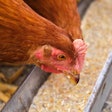Details of “the most modern feed mill of its kind” were presented at trade show Victam this month.
Commissioned by Sweden’s Kalmar Lantman Cooperative and built by Van Aarsen, the the EUR50 million (US$56.3 million) mill, in the southern Swedish port of Kalmar, has the capacity to produce 100 tons of feed per hour on five dedicated lines.
Among reasons for the company to commission the new feed mill was growing demand for poultry feed. It already had two mills on the site and initially considered upgrading and modernizing them. However, it concluded that, even if modernized, the two mills would always be “old” and so decided to make an additional investment and start again from scratch.
In 2009, Kalmar Lantman first sought proposals to replace its two mills, built in 1960 and 1981. The cooperative signed a deal with Van Aarsen in February 2012 and work began in April that year, with the shell of the new mill completed by May 2013. Construction took 25 months from start to finish and, aftera run-in period, the site become fully operational last year.
The feed mill has dedicated lines for poultry, pork and cattle feed, with the built areas covering 3,000 square meters and the total site extending to 18,000 square meters.
Lower running costs
Among requirements for the new mill was that it offer significant reductions in production costs, maximize production automation, and optimize hygiene and safety levels.
Van Aarsen says its smart engineering techniques have resulted in the mill offering 30 percent savings in on-site space through the use of state-of-the-art machines capable of producing a lower cost per ton of feed.
The mill’s whole production process is automated and products can be tracked at all stages of the production process, from raw materials intake to grinding, dosing, mixing, conditioning, pelleting, cooling, crumbing and sieving, coating, post-pellet liquid addition and the final end product, all of which can be remotely controlled by Van Aarsen’s automation specialists.
Built-in additional capacity
The mill runs 24 hours a day, five days a week, but can be operated over weekends should the need arise. Similarly, it has a sixth line that can be brought online as needed. The mill needs only two operators during the day and one at night to track the state of the production process. Operators can make any adjustments on the spot, simply by using a tablet. Remote control, and therefore security, is offered by Van Aarsen’s automation specialists.
All silos, bins and mixers are equipped with weighing facilities. This means raw materials or finished products can be seen anywhere in the production process, allowing stock levels to be monitored. Automatic sampling of finished product is possible in combination with the full automatic sample packing system.
The building is divided into a “dirty” section, for raw materials, and a “clean” section, for finished items. Conditioning times are extended in the mill to ensure hygienization and the in-feed destruction of Salmonella. Incoming air is purified as much as possible to prevent external impurities from entering the system.
Energy efficiency has also been a pivotal feature of the whole project, Van Aarsen says. The plant has been designed to make optimum use of gravity and also operates on high-efficiency motors to enable energy recovery from the warm water cooling to the accompanying frequency controllers. Heated liquid storage tanks are located in insulated areas in three different temperature zones to keep temperatures at constant levels.

















